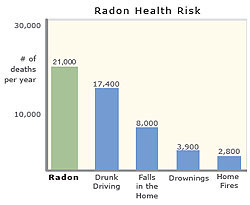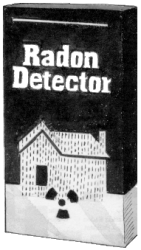"Reducing Radon Risks"
Note: EPA no longer updates this information, but it may be useful as a reference or resource.
Office of Air and Radiation (6601)
EPA Document #520/1-89-027
September 1992
There are two ways to protect your
family from Radon.
First, the hard way

Holding Your Breath
Test Your Home For Radon.
Your Family Will Breathe A Lot Easier.
With every breath, your family could be exposing themselves to a radioactive gas called radon. It's impossible to see, smell or taste. And it could be accumulating to unsafe levels in your home right now.
Radon is found at high levels in every state in America. It seeps into your home from the surrounding soil, and sometimes contaminates well water. It's the second leading cause of lung cancer in the U.S.- only cigarette smoking causes more lung cancer deaths. In fact, the Environmental Protection Agency and the Surgeon General have strongly recommended that all residences (except those above the second floor in multi-level buildings) be tested for radon.
Your family's risk of developing lung cancer from radon depends on the average annual level of radon in your home and the amount of time you spend there. The longer your exposure to radon, the greater the risk. And the risk is much greater for smokers.
Luckily, radon is easy and inexpensive to detect. And homes with high levels can be fixed. But it's up to you to find out whether radon is a problem in your home. Millions of people have tested their homes already.
Testing Is Easy And Inexpensive.
Because radon is completely invisible to sight, smell or taste, special detection kits are necessary to find a potential problem.
Radon detection kits are inexpensive and easy to use. You can purchase a kit at your local hardware store or other retail outlets. Contact your state radon office, local American Lung Association
or contact a "qualified" radon professional for more information on where to purchase a test kit.
After you've completed testing your home you simply mail the entire kit to the manufacturer for analysis (analysis is often included in the price of the kit). You can choose either a short-term or a long-term testing kit.
Short-term Testing Is The Quickest Way To Determine If A Potential Radon Problem Exists.
Short-term testing takes anywhere from a few days to several months to complete. The most common testing devices on the market right now are charcoal canisters, electret ion detectors and alpha track detectors. Short-term testing should be conducted in the lowest living area of your home, with the doors and windows shut, during the cooler months of the year.
Long-term Testing Is The Most Accurate Way To Test For Radon.
Long-term testing can take up to a full year. Alpha track detectors and electret ion detectors are the most common long term testing devices.
When you buy your kit, be sure to look for a test kit from a company that is "qualified" (see www.epa.gov/radon/radontest.html for more information on how to find a "qualified" radon service professional). Some State Radon offices also have a list of all radon measurement companies that meet their state requirements.
For More Information
Most test kits contain further information about testing. If your house does need to be fixed, you'll get additional information along with your test results. And when you have tested, pass this information on to your neighbor. But please be sure to test for radon as soon as you can. And you'll all breathe a lot easier.
 |
EPA estimates that radon causes thousands of cancer deaths in the U.S. each
year.
* Radon is estimated to cause about 21,000 lung cancer deaths per year, according to EPA's 2003 Assessment of Risks from Radon in Homes (EPA 402-R-03-003). The numbers of deaths from other causes are taken from the Centers for Disease Control and Prevention's 1999-2001 National Center for Injury Prevention and Control Report and 2002 National Safety Council Reports. |
Now the Easy Way.

Use One of These.
Common Myths About Radon
MYTH: Scientists are not sure that radon really is a problem.
FACT: Although some scientists dispute the precise number of deaths due to radon, all the major health organizations (like the Centers for Disease Control and Prevention, the American Lung Association and the American Medical Association) agree with estimates that radon causes thousands of preventable lung cancer deaths every year. This is especially true among smokers, since the risk to smokers is much greater than to non-smokers.
MYTH: Radon testing is difficult, time-consuming and expensive.
FACT: Radon testing is easy. You can test your home yourself or hire a qualified radon test company. Either approach takes only a small amount of time and effort.
MYTH: Radon testing devices are not reliable and are difficult to find.
FACT: Reliable testing devices are available from qualified radon testers and companies. Reliable testing devices are also available by phone or mail-order, and can be purchased in hardware stores and other retail outlets. Call your state radon office for help in identifying radon testing companies.
MYTH: Homes with radon problems can't be fixed.
FACT: There are simple solutions to radon problems in homes. Hundreds of thousands of homeowners have already fixed radon problems in their homes. Radon levels can be readily lowered for $800 to $2,500 (with an average cost of $1,200).. Call your state radon office for help in identifying qualified mitigation contractors.
MYTH: Radon affects only certain kinds of homes.
FACT: House construction can affect radon levels. However, radon can be a problem in homes of all types: old homes, new homes, drafty homes, insulated homes, homes with basements, and homes without basements. Local geology, construction materials, and how the home was built are among the factors that can affect radon levels in homes.
MYTH: Radon is only a problem in certain parts of the country.
FACT: High radon levels have been found in every state. Radon problems do vary from area to area, but the only way to know your radon level is to test.
MYTH: A neighbor's test result is a good indication of whether your home has a problem.
FACT: It's not. Radon levels can vary greatly from home to home. The only way to know if your home has a radon problem is to test it.
MYTH: Everyone should test their water for radon.
FACT: Although radon gets into some homes through water, it is important to first test the air in the home for radon. If your water comes from a public water supply that uses ground water, call your water supplier. If high radon levels are found and the home has a private well, call the Safe Drinking Water Hotline at 1 800-426-4791 for information on testing your water.
MYTH: It's difficult to sell homes where radon problems have been discovered.
FACT: Where radon problems have been fixed, home sales have not been blocked or frustrated. The added protection is some times a good selling point.
MYTH: I've lived in my home for so long, it doesn't make sense to take action now.
FACT: You will reduce your risk of lung cancer when you reduce radon levels, even if you've lived with a radon problem for a long time.
MYTH: Short-term tests can't be used for making a decision about whether to fix your home.
FACT: A short-term test, followed by a second short-term test* can be used to decide whether to fix your home. However, the closer the average of your two short-term tests is to 4 pCi/L, the less certain you can be about whether your year-round average is above or below that level. Keep in mind that radon levels below 4 pCi/L still pose some risk. Radon levels can be reduced in most homes to 2 pCi/L or below.
* If the radon test is part of a real estate transaction, the result of two short-term tests can be used in deciding whether to mitigate. For more information, see EPA's "Home Buyer's and Seller's Guide to Radon".
How to Order Publications from EPA
You can order Indoor Air Quality publications from EPA's National Service Center for Environmental Publications (NSCEP):
U.S. Environmental Protection Agency
National Service Center for Environmental Publications (NSCEP)
P.O. Box 42419
Cincinnati, OH 45242-0419
Website: www.epa.gov/nscep
Phone: 1-800-490-9198
Fax: (301) 604-3408
E-mail: nscep@bps-lmit.comNSCEP operates a Toll-free phone service for EPA Publication Assistance with live customer service representative assistance Monday through Friday from 9:00am-5:30pm eastern time. Voice Mail is available after operating hours. You can fax or e-mail your publication requests. For technical assistance with NSCEP web pages, write to: nscep_nepis.tech@epa.gov
Please use the EPA Document Number, which is usually bolded or highlighted, when ordering from NSCEP.
How Do I Order Other EPA Publications? Click Here
If you have further questions about radon, call your State or EPA Regional radon contact or the Radon Infoline at 1 800/SOS-RADON.
![[logo] US EPA](https://webarchive.library.unt.edu/eot2008/20081020054025im_/http://www.epa.gov/epafiles/images/logo_epaseal.gif)